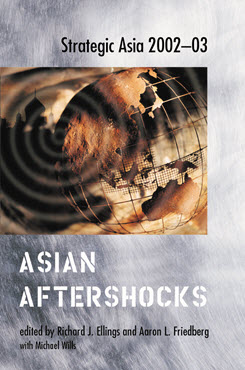Russia (Strategic Asia 2002-03)
This chapter shows that what is driving the Russia’s new strategy is not an imagined choice between East and West—which has been and will continue to be driven largely by hard geographical and economic realities—but rather Russians’ more forthright recognition of their country’s post-imperial power and interests. Indeed, the key to understanding Russian strategy over the past decade and for the next decade and longer is that imperial retrenchment takes a long time.
After the September 11, 2001, terrorist attacks against New York and Washington, Russian President Vladimir Putin gathered 21 leading Russian politicians to his Kremlin office to solicit their views about Russia’s options. One advocated support for the Taliban, two supported siding with the United States, and the rest argued that Russia ought to remain strictly neutral. Having heard them out in silence, Putin thanked them for their advice and declared his intention to offer unconditional support to the U.S.-led coalition against terrorism. Once the president had made his views clear, the assembled guests who had expressed opposition to the pro-American course fell quickly and insincerely into line.
This story captures a pervasive view of Russia’s new geopolitical stance in world affairs: the shift occurred after September 11, it represents a fundamental break with Russia’s previous strategy, and its fate hinges for the time being on one man’s vision and political skills. If this view is right, significant changes in Russia’s behavior in Asia might follow. At a general level, the age-old uncertainty about Russia’s true geopolitical identity might finally be resolved in favor of Europe. More practically, Moscow might be more inclined to alter its relationships with China, India, Japan, Korea, and Iran in ways that meet with favor in western capitals.
The turn to the West might also produce a different and more pliable Russian partner in the South Caucasus and Central Asia—one that is less competitive and more focused on the economic bottom line. This view is popular and accords superficially with the evidence, but it misses much of the real story. This chapter shows that what is driving the new approach is not an imagined choice between East and West—which has been and will continue to be driven largely by hard geographical and economic realities—but rather Russians’ more forthright recognition of their country’s post-imperial power and interests. Indeed, the key to understanding Russian strategy over the past decade and for the next decade and longer is that imperial retrenchment takes a long time. The loss of formal sovereignty over former imperial territories is just the beginning. Disengagement from areas long under imperial rule and management of the resulting security and economic challenges are anguishing, often chaotic, and always lengthy processes. Adjustment to a new and humbler international role is never swift or smooth. For an empire that was not defeated and dismembered in war, the proper measure of time for imperial retrenchment is a generation. What is new and important about Putin is what he represents: the first post-collapse generation in leadership and its promise of a more effective post-imperial grand strategy.
This chapter proceeds in four sections. The first analyzes the key background cause of Moscow’s strategic reappraisal, the interaction between Russia’s ongoing decline and its hierarchy of strategic objectives. The second assesses the strategic interactions that brought this underlying cause to the fore, the failure of the “multipolar” strategy Russia was pursuing before September 11. These two sections provide the critical context for the third, which tracks Moscow’s strategic shift, showing that the case for an adjustment had been building since 2000, and, indeed, that the Putin team had begun to engineer it well before September 11. The final section sets forth the trajectory Russia’s Asian strategy is most likely to follow over the next decade.
Strategic Asia
The Strategic Asia annual edited volume incorporates assessments of economic, political, and military trends and focuses on the strategies that drive policy in the region. Learn more about Strategic Asia.


